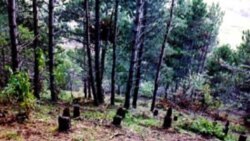By Gevorg Stamboltsian
Armenians’ continuing use of firewood as a source of heating remains a serious threat to the country’s endangered mountainous forests, new research funded by the World Bank concludes. The study conducted recently by a team of British and Swedish experts found that 73 percent of people living near the Armenian forests still resort to logging for keeping their homes warm in the winter. “It’s a hard situation,” said Andrew Mitchell, a British forestry consultant involved in the effort.
“The total volume [of wood] that’s removed each year is approximately 750,000 cubic meters,” he told RFE/RL. “And this is a very large volume if you compare it with the officially planned volumes. So it is likely to have an environmental impact.”
The total area of lands covered by woods in Armenia has already shrunk considerably since the severe energy crisis in the early 1990s which left the population without electricity and central heating. Although the power shortages were eliminated by 1996 many people, especially in rural areas, still prefer firewood to the more expensive electricity, and the authorities have still not restored natural gas supplies to the majority of households.
The authors of the World Bank study believe that poverty is the main driving force of the continuing deforestation. But Armenian environmentalists say there are also powerful commercial interests involved, pointing to the fact that wood is heavily used by local firms producing construction materials and furniture. They warn that the deforestation is causing soil
erosion and having other negative effects on the country’s ecological system.
“It’s a devastating business,” admitted Ruben Petrosian, the recently appointed head of Hayantar, the government’s main forestry agency.
Petrosian complained that the state now spends less than $300,000 a year on forest protection and restoration -- a far cry from Soviet times when an equivalent of $4 million was annually budgeted for that purpose. “In 1985, for example, new trees were planted on 3,500 hectares of land, creating new forests,” he said.
However, Hayantar itself is viewed by many as a major cause of the problem. Its employees are thought to routinely sanction illegal logging in exchange for kickbacks. Their modest salaries only contribute to the corruption.
“The temptation for corruption must be very large,” Mitchell said. “If I was in that position and my family was sick and I needed to send them to hospital, I would take a bribe.”
Mitchell added that tougher penalties alone would not remedy the situation. Besides, he continued, the government’s existing logging regulations are not clear enough. “It is difficult to say what is legal and what is illegal,” he said.
Hayantar, which was previously controlled by the Armenian Ministry of Environment, was transferred to the Agriculture Ministry in January amid protests from 14 environmental protection groups. In a joint letter to President Robert Kocharian, they warned that the move could have “dangerous consequences” for the country’s shrinking green areas. They claimed that the Agriculture Ministry lacks the expertise and commitment to protect them.




